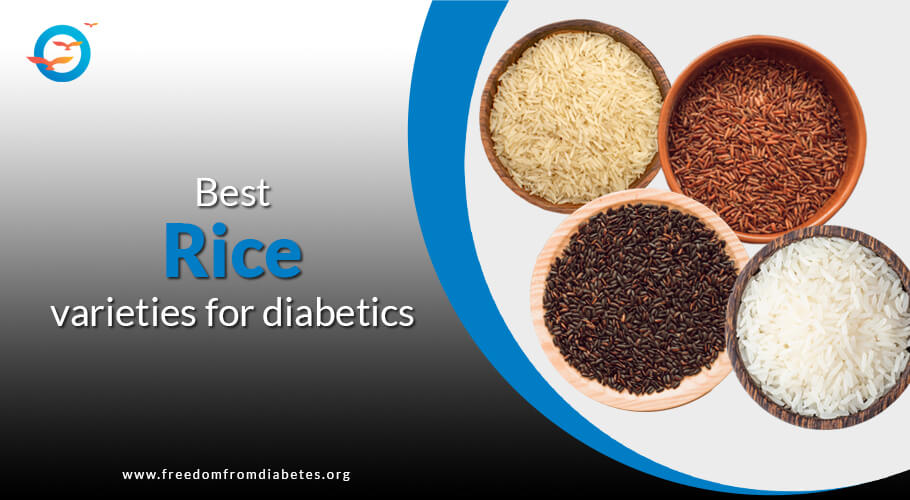Best Rice for Diabetics

Best Rice for Type 2 Diabetes
Every diabetic knows the dangers of consuming high-GI foods, and in recent times, rice has become the villain to many thanks to its high carbohydrate content and high Glycemic Index (GI).
This is a rating between 0 and 100 that ranks foods according to their rate of sugar absorption, from recommended low GI foods between 0 and 50 to medium and high GI foods, 51 to 100, which are not advisable for people suffering from high blood sugar and related health problems.
But if you’re one of those people who can’t do without their daily quota of rice, you don’t have to despair. There are several varieties of rice that are quite safe to have for several reasons.
Best Rice for Sugar Patients
1. Brown Rice for Diabetes
Considered a health food, because unlike white rice, which is deficient in germ and bran, brown rice is rich in both. White rice on the other hand does not retain nutrient-rich germ but contains only the starchy endosperm.
Brown Rice Nutritional profile
One cup of (100 grams of cooked brown rice provides the following nutrition:
- Carbs: 26 gm
- Fiber: 1.5 gm
- Protein: 3 gm
- Manganese: 40% of RDV
- Thiamine (B1): 15% of RDV
- Niacin (B3): 15% of RDV
- Pantothenic acid (B5): 8% of RDV
- Pyridoxine (B6): 8% of RDV
- Selenium: 10% of RDV
- Magnesium: 10% of RDV
- Phosphorus: 10% or RDV
- Zinc: 7% of RDV
- Calories: 124
Brown Rice Benefits for Diabetes
- Brown rice is a good source of fiber, vitamins, and minerals.
- It is rich in flavonoids, which fight the anti-oxidation effects of free radicals.
- Its high fiber content and slow absorption make it beneficial for digestive health and induce a feeling of fullness that can help diminish hunger pangs and induce weight loss.
- Brown rice has been shown to reduce post-prandial blood sugar in diabetics, and it also offers protection against developing type 2 diabetes. This is thought to be the result of its high fiber and magnesium content.
2. Red Rice for diabetes/Navara Rice
Red rice, aka Navara Rice, gets the majority of its health benefits from a flavonoid and powerful anti-oxidant, named anthocyanin. Anthocyanin gets its name from Anthokyan, a chemical compound that produces the distinctive reddish color that the rice is known for.
Other examples of foods rich in anthocyanin are berries, grapes, and currants—all these are a rich red, purple or blue color. These flavonoids give red rice its anti-cancer, anti-inflammatory, and anti-microbial properties, and also help prevent heart damage.
Red Rice Health Benefits
1. Low Glycemic Index.
Red rice has a low GI rating, making it effective in preventing spikes in blood sugar. This means diabetics can consume this variant in moderate amounts.
2. Heart Healthy
High magnesium and anti-oxidant levels make red rice very effective in regulating blood pressure and minimizing risks to heart health.
3. Weight Control
The high fiber content of red rice helps control weight gain. It induces a feeling of fullness that fights hunger pangs and keeps you from unhealthy snacking. In addition, the fiber is good for your digestive tract and also works to slow down blood sugar absorption.
4. Reduced Inflammation
Inflammation in the body is responsible to a large degree for damage to your internal organs, which triggers disorders like insulin resistance. Red rice helps reduce inflammation in the body, thanks to the vitamins and minerals—like iron, calcium, and selenium, among others—that it contains.
3. Black Rice for diabetes
In ancient China, black rice was so prized for its unique nutrition that only royals were allowed to consume it. Today, thankfully, everyone can enjoy the many benefits it offers.
Black rice, like red rice, gets its color from its anthocyanin content. This is a potent antioxidant that makes black rice so nutritive. Black rice is also rich in protein—in fact, it has the highest protein content of all the rice variants.
Black Rice Nutrition Profile
- 100 gm of black rice provides the following
- Protein 9 grams (compared to 7 gm of common rice varieties)
- Carbs: 34 gm
- Fiber: 3 gm
- Iron: 12% of RDV
Black Rice Health Benefits
1. Antioxidant-rich
Black rice is high in anti-oxidants—It contains some 23 different anti-oxidant compounds, including flavonoids and carotenoids. These micronutrients protect cells from oxidative damage, caused by free radicals.
2. Anti-cancer properties
Oxidative stress is linked to a higher risk of chronic disorders like heart damage, Alzheimer’s, and some cancers. Black rice, by virtue of its anti-oxidative properties, is associated with a reduced risk of some cancers.
3. Heart-healthy
Like the red variant, black rice’s flavonoid content has been linked to a decreased risk of heart disease. It also is believed to improve cholesterol and triglyceride levels.
4. Improves eye health
Vision problems are a common complication of long-term diabetes. Black rice contains some carotenoids that are known to improve eye health, by filtering our dangerous blue light, and reducing macular degeneration, making it an invaluable addition to the diabetic diet.
5. Gluten-free
If you have celiac disease, grains like rice are completely off-limits. But not black rice. Since it is completely free of gluten, people with celiac disease can safely consume it, without worrying about the usual consequences of gluten allergy, such as bloating, abdominal pain, and damage to the intestine.
4. Hand-pounded Rice for diabetes
Hand pounding refers to the process of pounding the rice in a mortar & pestle or in a stone grinder. The pounding removes the husk, without destroying the bran, thus leaving the healthy nutrients untouched.
Machine pounding, by contrast, creates heat, which destroys much of the nutrient quotient contained in rice. It also makes the rice easier to cook and digest.
Hand-pounded Rice Nutritional benefits
- Nutrient profile (per 100 gm)
- Protein: 7.5 gm
- Carbs: 76 gm
- Fiber: 1
- Calcium: 23 mg
- Iron: 3.6 mg
- Cholesterol: 0
- Calories; 325
Health benefits of hand pounded rice
- Hand-pounded rice is made of complex carbs, which keeps you feeling full for longer.
- In addition, it contains a number of nutrients like iron, calcium, Vitamins B, K & E, manganese, magnesium, selenium, and several amino acids.
- Its high fiber content, improves digestion, while magnesium and selenium help improve blood circulation, normalize colon function and reduce cancer risks.
- Hand-pounded rice is rated low on the Glycemic Index, making them safe for diabetics.
- There are many common variants of hand-pounded rice and they mostly go by their vernacular names, such as Hath Sadi, Dheki, and Kaikuthal Arisi
- Here are the best Wheat Varieties that a diabetic can try...!
FAQs
Can I eat rice if I have diabetes?
Yes, but it's important to choose whole grain options like brown rice , red rice black rice and eat them in moderation to keep blood sugar levels stable.
Which rice is good for diabetic patients
Brown Rice, Red Rice, Black Rice, Hand-pounded rice.
Is brown rice better than white rice for diabetes?
Yes, brown rice is better than white rice for people with diabetes. Brown rice is higher in fiber, which slows down the absorption of sugar and helps keep your blood sugar levels stable. White rice, on the other hand, has a higher glycemic index and can cause quicker spikes in blood sugar.
Can I eat basmati rice, if I have a diabetes?
Yes. Basmati rice has a low to medium glycemic index. If you have diabetes, you can include small portions of basmati rice in your healthy diet.
How does rice affect blood sugar levels?
Rice can impact blood sugar levels because of its high carbohydrate content and elevated glycemic index (GI). Diabetics should be cautious with rice, as it can lead to increased blood sugar levels.
Can diabetics eat rice every day?
Diabetics can eat rice, but it’s very important to do so in moderation and choose low-glycemic varieties like brown rice or basmati rice.
How much rice can a diabetic safely eat?
Diabetics can safely eat rice in moderation. A typical serving size is about 1/2 cup of cooked rice. It's important to monitor portion sizes and choose low-glycemic varieties. Pairing rice with vegetables and proteins can help manage blood sugar levels.

